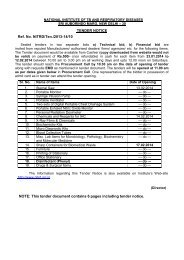The Indian Journal of Tuberculosis - LRS Institute of Tuberculosis ...
The Indian Journal of Tuberculosis - LRS Institute of Tuberculosis ...
The Indian Journal of Tuberculosis - LRS Institute of Tuberculosis ...
You also want an ePaper? Increase the reach of your titles
YUMPU automatically turns print PDFs into web optimized ePapers that Google loves.
A.K. CHAKRABORTY ETAL<br />
5% in level 2 & 20% in level 3 will increase DTP<br />
efficiency to 83.44% (column 8, second row from<br />
bottom in Table 7). Other alternative<br />
combinations are also shown in the Table.<br />
Discussion<br />
Introduction <strong>of</strong> SCC regimens <strong>of</strong> high efficacy<br />
in DTP in 1983 could be viewed as a measure for<br />
increasing DTP efficiency through improving the<br />
treatment efficiency, DTP efficiency, however, is<br />
not only related to treatment efficiency but to<br />
other variables as well, e.g., case-finding<br />
efficiency (CF efficiency), efficiency <strong>of</strong><br />
implementing the SCC regimen policy and,<br />
finally, to regimen acceptance & conformity by<br />
patients (compliance). Through this model, an<br />
attempt is made to demonstrate the role <strong>of</strong>. some<br />
<strong>of</strong> these key variables in determining the likely<br />
output from the policy <strong>of</strong> augmenting treatment<br />
efficiency with SCC, as a lone measure <strong>of</strong><br />
increasing DTP efficiency.<br />
DTP efficiency/CF efficiency under SCC .<br />
<strong>The</strong> model confirms the hypothesis made by<br />
the earlier workers 1,2,3 that given the resources<br />
made available for NTP, improvement in CF<br />
efficiency is a more crucial corrective variable<br />
than trying to change only treatment efficiency<br />
through selective augmented inputs. At the lower<br />
levels <strong>of</strong> CF efficiency (say 33%), the additional<br />
benefit accruing from SCC over SR is not<br />
appreciable, being below 10% in terms <strong>of</strong> the<br />
gain in DTP efficiency. Even this extent <strong>of</strong><br />
improvement with SCC could result with 100% <strong>of</strong><br />
the cases diagnosed in DTP being so treated<br />
which, in any case, may not be. possible in the<br />
foreseeable future. It would require a<br />
substantially higher CF efficiency to obtain still<br />
better results (say 70% CF efficiency will gain<br />
about 15% greater DTP efficiency) with patient<br />
compliance remaining at the currently observed<br />
level (columnV, row one from top and fourth row<br />
from bottom in Table 7). In the unlikely situation<br />
<strong>of</strong> 100% CF efficiency and 100% cases put on<br />
SCC, the likely DTP efficiency could be 78.9%,<br />
which is the maximum possible under DTP when<br />
the patient compliance remains unchanged. This<br />
could, <strong>of</strong> course, be compared with the situation<br />
in which 100% CF efficiency and 100% cases<br />
being placed on SR will give DTP efficiency <strong>of</strong><br />
49.7 (Table 7), highlighting the benefit from SCC.<br />
Compliance structure and DTP efficiency<br />
<strong>The</strong> model has shown that treatment efficiency<br />
and DTP efficiency are also directly proportional<br />
to changes in compliance structure i.e.,<br />
proportional distribution <strong>of</strong> patients complying in<br />
varying proportions at different levels <strong>of</strong><br />
compliance. <strong>The</strong> rates <strong>of</strong> compliance, no doubt,<br />
are also dependent on the treatment regimen :<br />
<strong>The</strong> current rates <strong>of</strong> compliance at levels 1 & 2,<br />
are high both for SR and SCC. In the model<br />
developed by Radhakrishna 2 , compliance at<br />
level 4 has been taken as the overall extent <strong>of</strong><br />
case-holding efficiency, ignoring the rates <strong>of</strong><br />
compliance at other levels. Under the<br />
circumstances, the resultant DTP efficiency <strong>of</strong><br />
8%, worked out by him may not represent the<br />
actual DTP efficiency because some cases in<br />
levels 1, 2 and 3 do convert to a stable smear<br />
negativity 1,12 . This has been demonstrated by the<br />
model developed by Srikantaramu et al 1 , still later<br />
by Radhakrishna 3 and now through the use <strong>of</strong> the<br />
factor <strong>of</strong> compliance structure.<br />
Apart form chemotherapy, another factor<br />
utilised in the model constructed by Srikantaramu<br />
et ai ] contributing to sputum conversion was the<br />
phenomenon <strong>of</strong> “self-cure”. <strong>The</strong> annual<br />
proportion <strong>of</strong> self-cures occurring naturally has<br />
been estimated to be 20% <strong>of</strong> the total cases in the<br />
community, in an epidemiological survey 13 and,<br />
understandably, the information on self cures<br />
amongst tuberculosis cases attending clinics is not<br />
known. If “self cure” is applied to cases in the<br />
lower levels <strong>of</strong> compliance (levels 1, 2 and 3),<br />
then sputum conversion should be in excess <strong>of</strong><br />
20%, even in level 1. <strong>The</strong> observed sputum<br />
conversion <strong>of</strong> about 22% in level 1 under SR,<br />
therefore, could possible represent “self cure”<br />
(Table 1, column 4).<br />
It is interesting to study the effect <strong>of</strong> different<br />
regimen mixes varying with compliance structure<br />
(Table 5). At the regimen mix <strong>of</strong> situation II, with<br />
90% SR & 10% SCC, raising the current<br />
compliance (column 4) to a very high level<br />
(column 8) would result in an increase in<br />
treatment efficiency <strong>of</strong> 13.58%. On the other<br />
hand, in situation X, with 10% SR & 90% SCC, a<br />
similar improvement in compliance would give a<br />
5.58% improvement in treatment efficiency.

















